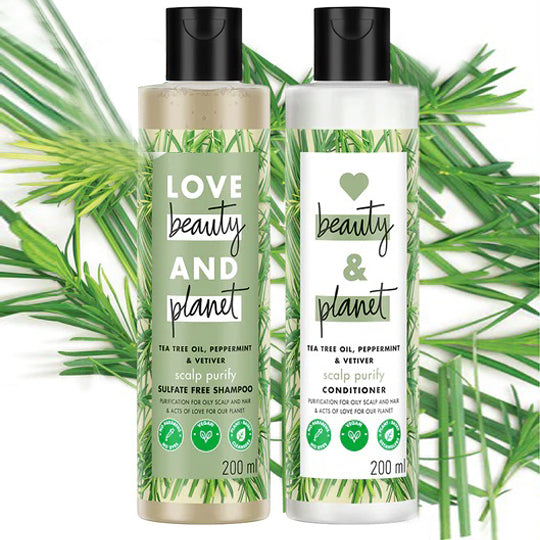Anti Dandruff Range
Frequently Asked Questions
A. When looking for a shampoo for dandruff, look for one that combines the goodness of Coconut Oil and Tea Tree Oil. So you get the best combination of cleansing and moisturising.
A. The best anti dandruff shampoo in India should have ingredients like Peppermint, Tea Tree Oil, Coconut Oil, Walnut Shell Powder, etc. Additionally ensure that your shampoo is sulfate-free.
A. It is recommended to use the best dandruff shampoo twice weekly for optimal results.
A. If you are facing dandruff issues you must incorporate use of an anti-dandruff conditioner in your washing routine.
A. Conditioners which combine the goodness of Tea Tree Oil effectively complements dandruff shampoo by reducing dandruff, soothing the scalp, nourishing hair, and minimizing frizz.
A. Anti dandruff hair mask can aid in controlling scalp sebum production and reduce dandruff buildup.
A. When combating dandruff, whether to apply a hair mask on dry or wet scalp varies. Using a dandruff hair mask can be effective, but the application quantity should be precise.
A. Yes, Hair scrub for dandruff may aid in dandruff reduction by exfoliating and soothing the scalp.
A. If you have sensitive skin look for scalp scrubs that are gentle on your skin. Always remember to do a patch test if you have sensitive skin.
A. Hair serums formulated to combat dandruff can help by targeting the dandruff causing fungus directly on the scalp.
A. Yes you can use a hair serum together with your anti dandruff shampoo, as serums are typically applied post-wash to enhance softness and smoothness.
Dandruff Overview
You know those white flakes you sometimes see in your hair or on your clothes? Yes, that's dandruff! It happens when tiny pieces of dry skin from your scalp start flaking off. And guess what? It can make your head feel super itchy too. It's probably a mix of things like too much oil on your scalp and a certain type of fungus called Malassezia. And things like stress, chilly weather, and some hair products can make it worse.
Read More...Understanding what is dandruff
Excessive flaking of dead skin cells from the scalp, sometimes known as dandruff, is a prevalent skin condition. These flaky bits can be embarrassing and painful, and they're usually visible on the scalp. They can even fall over clothes. Dandruff is mostly caused by the rapid loss of skin cells, which can be affected by a lot of different things.
When there's too much growth, it can irritate and inflame the scalp, which makes flaking worse. Dry skin, hormonal shifts, stress, specific hair products, and climatic conditions (such as cold) are other variables.
Although dandruff is common, it is usually not a medical emergency. However, it can be annoying and impact a person's self-esteem and overall happiness. Good scalp hygiene and managing stress and dry skin are also important components of effective management strategies.Signs That You Have Dandruff
Keep an eye out for the below mentioned signs to know if you have dandruff.
- White flakes on the hair and scalp, which are bits of dead skin
- Occasional scalp itchiness
- Dry or greasy scales on the scalp
- Yellowish to reddish scaly bumps along the hairline in severe cases
What Causes Dandruff?
Dandruff can be caused by various factors, leading to an itchy scalp and those annoying white flakes. Here's a breakdown of common causes -
1. Dry Skin:
If you have dry skin, chances are it's causing your dandruff. This can worsen during colder months when skin tends to get even drier. The solution? Moisturize your scalp regularly with shampoos that add moisture. Look for the best anti dandruff shampoo to combat dandruff effectively.
2. Infrequent Shampooing:
Believe it or not, not shampooing enough can lead to dandruff. When you skip washes, oil builds up on your scalp, contributing to flakiness. Using a stronger shampoo or shampooing more frequently can help break down this oil barrier and reduce dandruff. Consider incorporating anti dandruff natural hair mask into your routine a few times a week for better results.
3. Allergies:
Allergies, even to hair care products, can trigger dandruff. If you experience scalp irritation or itchiness after using certain products, you might be allergic to them. The solution is to stop using the suspected product and try eliminating other potential allergens from your hair care routine. Experiment with different products to find what works best for your scalp.
How to get rid of dandruff
Getting rid of dandruff involves incorporating multiple dandruff specific products in your hair care routine:
1. Use an anti-dandruff shampoo:
It is important to pick a shampoo that can show great results against dandruff. We recommend using our Tea Tree, Peppermint & Vetiver Sulfate Free Purifying Shampoo. Using plant-based cleansers, our Tea Tree and Vetiver Detoxifying Shampoo leaves both you and the earth looking and feeling better. It's also free of sulfates and parabens. The earthy, invigorating aroma of vetiver, organically harvested from Haiti's Les Cayes region, clarifies the scalp and detoxifies the hair.
2. Include a nourishing conditioner:
Follow up with a nourishing conditioner after shampooing to replenish moisture to the scalp and hair. Apply the conditioner from mid-length to the ends of your hair, avoiding the scalp to prevent weighing it down. We recommend using our Tea Tree, Peppermint & Vetiver Paraben Free Purifying Conditioner. It combines 100% organic Coconut Oil and Natural Tea Tree Oil which helps combating dandruff.
3. Scalp Scrub:
Incorporate a scalp scrub into your hair care routine once or twice a week to exfoliate the scalp and remove dead skin cells and product buildup. Choose a gentle scrub with exfoliating agents, combined with soothing ingredients like coconut oil or tea tree oil. Gently massage the scrub into your scalp using circular motions, then rinse thoroughly with warm water. You can consider our Tea Tree Oil & Peppermint Scalp Scrub. It combines the goodness of natural Tea Tree Oil, Walnut Shell Powder and Peppermint Oil that work together to get rid of dandruff.
Incorporating these steps into your hair care routine can help effectively manage dandruff and promote a healthier scalp and hair. Remember to be consistent with your regimen and give your scalp time to adjust to the new products and treatments.














